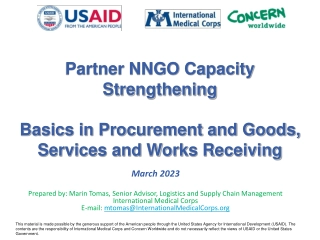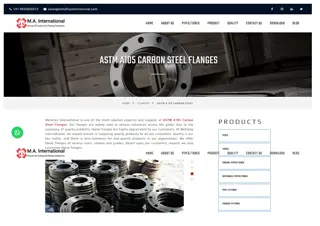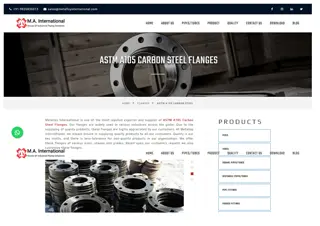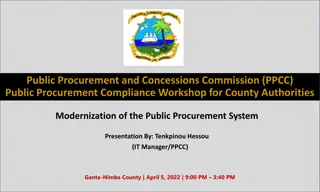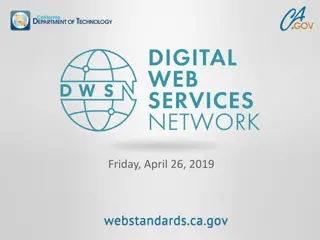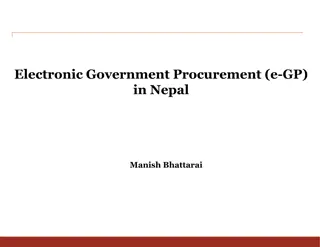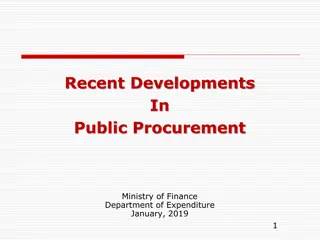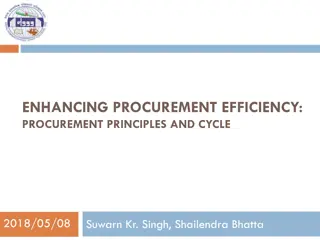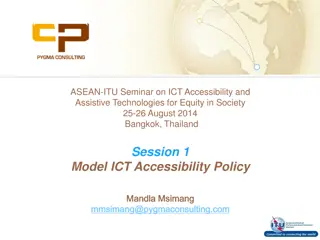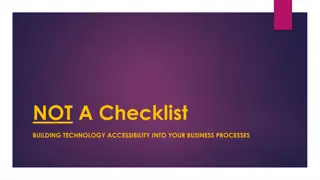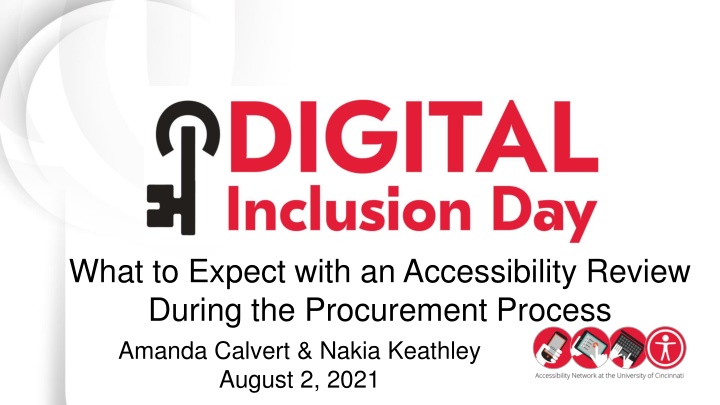
Accessibility Reviews in Procurement Process
Learn the importance of accessibility in third-party EIT purchases, discover the purpose of ACR and VPAT, and know what to expect during an accessibility review process in the procurement process. Legal requirements, including Section 504 Rehabilitation Act and Americans with Disabilities Act, are highlighted along with how Section 508 of the Rehabilitation Act applies to third-party products.
Download Presentation

Please find below an Image/Link to download the presentation.
The content on the website is provided AS IS for your information and personal use only. It may not be sold, licensed, or shared on other websites without obtaining consent from the author. If you encounter any issues during the download, it is possible that the publisher has removed the file from their server.
You are allowed to download the files provided on this website for personal or commercial use, subject to the condition that they are used lawfully. All files are the property of their respective owners.
The content on the website is provided AS IS for your information and personal use only. It may not be sold, licensed, or shared on other websites without obtaining consent from the author.
E N D
Presentation Transcript
What to Expect with an Accessibility Review During the Procurement Process Amanda Calvert & Nakia Keathley August 2, 2021
Housekeeping ASL Interpreters: This session has ASL interpreters. Using the Side by Side view should allow for the best view. Closed Captions: Live transcript has been enabled for this session. To view the captions please click on the arrow/caret next to the CC icon and select View Subtitles . Recorded Session: This presentation is being recorded and will be shared for future trainings. Q&A: For any questions you may have, please select the Q&A icon in your menu bar and type your questions in the Q&A panel. Questions will be reviewed at the end of the session and answered as time allows.
Learning Outcomes Learn why accessibility is important for third party EIT purchases. Understand what an ACR and a VPAT are and their purpose at UC. Know what to expect during the accessibility review process.
Fact or Fiction It s poll time!
Why is it important It s the law It s the right thing to do
Legal Requirement Section 504 Rehabilitation Act "No otherwise qualified individual with a disability in the United States . . . shall, solely by reason of her or his disability, be excluded from the participation in, be denied the benefits of, or be subjected to discrimination under any program or activity receiving Federal financial assistance
Legal Requirement cont. Americans with Disabilities Act Applies to employees, students, guests and visitors Requires accommodations and access Case law and DOJ repeatedly uphold that the ADA applies to electronic environments
How do we know this applies to third party products? Section 508 of the Rehabilitation Act of 1973 In 1998, Congress amended the Rehabilitation Act of 1973 to require Federal agencies to make their electronic and information technology (EIT) accessible to people with disabilities. The law (29 U.S.C 794 (d)) applies to all Federal agencies when they develop, procure, maintain, or use electronic and information technology. https://www.section508.gov/manage/laws-and-policies
Beyond Compliance Conforming to accessibility standards does more than keep us out of the news and the courts Student experience and success Visibility can lead to awareness and efficiencies It s the right thing to do!
Who does UCs accessibility process within procurement benefit? All students All faculty All staff Community Our vendors
Accessibility in a buyers journey Discovery Consideration Decision Implementation Renewal Include a11y in requirements and customizations Training and accommodations plan for known barriers. Include a11y language in RFP, contract, etc. Request IT a11y review Understand potential barriers Request updated ACR/VPAT Request IT a11y review Ask about accessibility Request an ACR/ VPAT Make a11y a criterion Accessibility in a Buyer s Journey Note: a11y = Accessibility
Before the review request Criterion Google Ask ACR/VPAT
ACR or VPAT? Voluntary Product Accessibility Template (VPAT): a blank template that can be filled out to account for a product or service s state of accessibility. Accessibility Conformance Report (ACR): a completed VPAT (i.e., the blank template is filled out) along with all of the other details in the report. In the marketplace, the term VPAT dominates, even though it s usage is technically incorrect. Vendors and procurement departments (including UC) use VPAT but what they really mean is ACR.
What is a VPAT? Voluntary Product Accessibility Template A document that explains how information and communication technology (ICT) products such as software, hardware, electronic content, and support documentation meet (conform to) the Revised 508 or WCAG Standards for IT accessibility. VPATs help organizational buyers to assess ICT for accessibility when doing market research and evaluating proposals. Template: https://www.itic.org/policy/accessibility/vpat
What is a VPAT? Simplified Voluntary Product Accessibility Template The VPAT is a document that the vendor completes. The document provides crucial information about potential accessibility barriers providing guidance to buyers during the procurement process.
Who creates a VPAT? The owner of the product (vendor) is responsible for creating a VPAT. The best VPAT s are typically completed by an IT professional or a third-party vendor.
How does UC use VPATs Guidance Procurement Testing Temporary Accommodation Planning Audit trail
What do we look for in a VPAT? 508 or WCAG 2.0+ AA+ Version VPAT 2.3+ Accessibility contact Recent completion date (<12 months) Detailed responses
Accessibility Review Request Process A11y Summary Vendor Roadmap Temporary Accommodation Plan Kick-off A11y Test Results Submit A11y review request Assessment Feedback Accessibility Testing IT Service Portal Access Plan Review https://www.uc.edu/about/accessibility-network/purchasing/accessibility-review.html
Submit Accessibility Review Request IT Service Portal Service Catalog: Accessibility Services, Accessibility Network UC Accessibility Network website UC Accessibility Network Intranet site
Accessibility Review Request Form Explained Requested for: Purchasers should put the business owner s name here. The business owner will then be included in communications and meetings. Type of asset to be reviewed: Third Party Product: Use this form to request a third party product review. This includes app and websites from any third party vendor. Website or Webpage: Use this form to request an accessibility scan for UC websites only. (This does not include third party apps or websites.) Document: Use this form to request assistance making a UC document accessible. (Example: PDF and Microsoft Office Documents)"
Accessibility Review Request Form Explained cont. PACE Function of product Who will have access (audience) Number of users Integrated/embedded on UC website Description
Accessibility Review Risk Assessment Low, Medium, High VPAT Review Feedback Next steps
Feedback Typically, within 5 business days Email sent through IT Service Portal Decision, responsibilities and next steps Blockers and/or Barriers found in VPAT
Decision Example Feedback Email The Accessibility Conformance Committee has reviewed this request and determined that additional testing will need to be performed to provide information and the best guidance for purchase and/or use of this product in the fulfillment of equal access. It is important to note that ability status of any person (ie: students, staff and faculty) may not be required to be disclosed and is not static, and as such, when you purchase a product that has known barriers to accessibility you are taking somewhat of a risk. Should you hire someone who needs to use this product who does have a disability or should someone who works/studies at the university now become disabled, the office requiring the use of this product would be responsible for ensuring that they can still do their work and accessibility issues would need to be addressed at that time. If you have additional questions about this review or your next steps, please contact Nakia Keathley. Responsibility Next Steps The Accessibility Network (AN) will perform an automated scan and a full manual accessibility test of the product. You will receive a meeting request where we will give you more information on what to expect and timeline. The AN will provide a summary and full report on our findings during the automated and manual accessibility testing. If blockers or significant barriers are found we will work with you to put together an access plan to ensure fulfillment of equal access. Recommended: Work with Office of General Counsel to include accessibility language within your contract.
Decision Need more information Accessibility testing not required Accessibility testing required
Next Steps Communication plan Testing plan Accessibility rider for contract Contract renewal
Accessibility Test Process Kick off call Accessibility testing* Results review Accommodation planning *Accessibility Network only
Kick Off Good to know Always recorded 30 60 minutes Accessibility Network will schedule Purpose: Gather all information needed to perform a test. Tester access Demo of product Scope defined Attendees Business owner: can answer how to get access and provide a demo. Buyer/purchaser typically will not be able to answer these questions. Vendor: recommended but optional Accessibility Network: QA team member and program manager
Accessibility Test A full accessibility test consists of two types of tests, automated and manual. Each test is critical to identify any accessibility barriers within the product. Automated tests Automation tools Noninvasive 15 - 30% of errors can be found Manual tests Human testing Screen reader, keyboard User experience Review/confirm automated errors.
Results Review Purpose: Review the results from the Accessibility test. Good to know 30 60 minutes Accessibility Network will schedule Explanation of results and how to use the spreadsheet Next steps Vendor roadmap Accommodation planning Attendees Business owner Vendor: recommended but optional Accessibility Network: QA team member and program manager
Vendor Roadmap Vendor s plan to remediate accessibility issues Based on prioritization, vendor s review Should be scheduled as part of vendor s development cycle
Temporary Accommodation Plan TEMPORARY Proactive Communication and Process Documented
Now what? Communication Contract renewal
Fact or Fiction repeat It s poll time, again. repeat
Fact or Fiction Revealed Revealed 1. If we purchase technology, we cannot make changes to the product; therefore, we are not accountable for the product s conformance to accessibility. 2. I must always have a VPAT before I submit an accessibility request. 3. The course I teach requires you to have vision (pilot, doctor, nurse, digital design, etc) so my product, by nature, will not be accessible and I do not need to submit it for an accessibility review. 4. Because the accessibility review process can take time, it will hold up my purchase request.
Summarize Accessibility as a criterion Accessibility review request Access plan Kick-off, Results, accommodations
Questions and Answers Please post your questions in the Q&A panel by selecting the Q&A icon in your Zoom tool bar.
Thank you Amanda Calvert, IT Accessibility Program Director calveraa@ucmail.uc.edu Nakia Keathley, IT Accessibility Program Manager keathlna@ucmail.uc.edu

